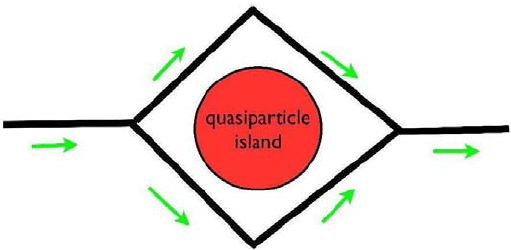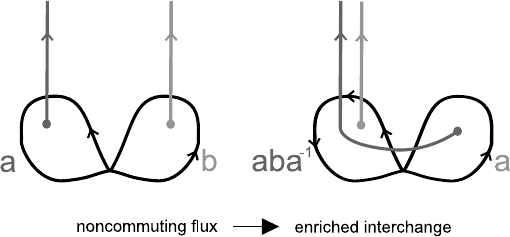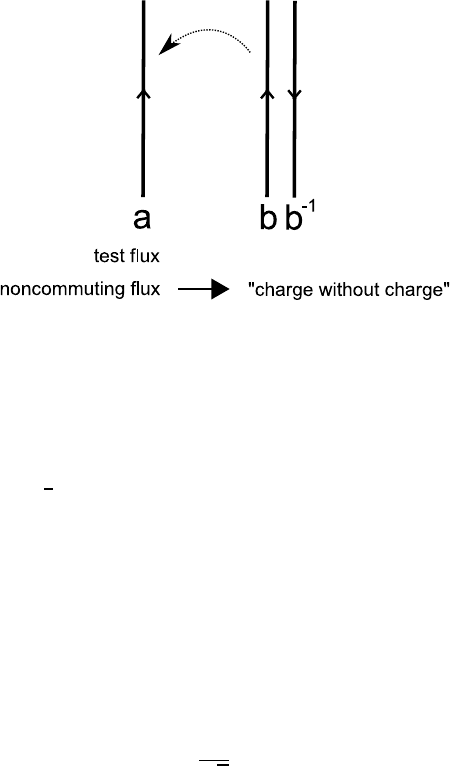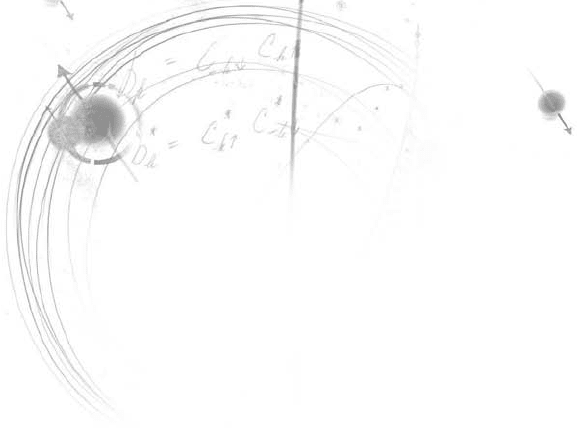Cooper L.N., Feldman D. (Eds.) BCS: 50 Years
Подождите немного. Документ загружается.


October 4, 2010 10:21 World Scientific Review Volume - 9.75in x 6.5in ch22
BCS as Foundation and Inspiration: The Transmutation of Symmetry 551
moving around a flux Φ acquires, according to the minimal coupling gauge
Lagrangian, phase
exp ibq
I
dt~v ·
~
A
= exp ibq
I
d~x ·
~
A
= e
iΦbq
(19)
(Note that in two dimensions the familiar flux tubes of three-dimensional
physics degenerate to points, so it is proper to regard them as particles.) If
the flux is aΦ
0
, then the phase will be e
2πi
ab
m
. Note that this phase does not
depend on the velocity, curvature, or any details of the particles’ dynamics,
other than the topology of how their world-lines interweave. For that reason,
we say we have a topological interaction.
Composites with (flux, charge) = (aΦ
0
, bq) will generally be particles
with unusual quantum statistics. As we implement the interchange σ
j
, each
charge cluster feels the influence of the other’s flux, and non-trivial phase is
required. A close analysis shows that the anomalous statistics is such as to
preserve a spin-statistics connection, in the form
e
2πiJ
= e
iθ
(20)
Evidently quantum statistics, both conventional and unconventional, can
be regarded as a special type of long-range interaction. It is remarkable
that this interaction is not associated with the exchange of any massless
particle. Indeed, our specific model, with broken gauge symmetry, can be
fully gapped. One can also have topological interactions, involving simi-
lar accumulations of phase, for non-identical particles. What governs these
topological interactions are the quantum numbers, or more formally the su-
perselection sectors, of the particles, excitations or clusters involved, not
their detailed internal structure.
The phase factors that accompany winding have observable consequences.
They lead to a characteristic “long range” contribution to the scattering
cross-section, specifically
dσ
dφ
= sin
2
π
ab
m
1
2πk
1
sin
2
φ
2
(21)
It diverges at small momentum transfer and in the forward direction. A
cross-section of this kind was first computed by Aharonov and B¨ohm
6
in
their classic paper on the significance of the vector potential in quantum
mechanics. If we could do experiments in the style of high-energy physics,
forming beams of quasiparticles and scattering them, we would be in great
shape. Unfortunately, as a practical matter the highly characteristic cross-
sections associated with anyons may not be easy to access experimentally for

October 4, 2010 10:21 World Scientific Review Volume - 9.75in x 6.5in ch22
552 F. Wilczek
Fig. 2. A schematic interference experiment to reveal quantum statistics. One
measures how the combined current depends on the occupation of the quasiparticle
island.
the examples that occur as excitations in exotic states of condensed matter
(although it could be worth a try!).
Interferometry appears to be more practical. The basic concept is simple
and familiar, both from optics and (for instance) from SQUID magnetome-
ters. One divides a coherent flow into two streams, which follow different
paths before recombining. The relative phase between the paths determines
the form of the interference, which can range from constructive to destruc-
tive recombination of the currents. We can vary the superselection sector of
the area bounded by the paths, and look for corresponding, characteristic
changes in the interference. (See Fig. 2.) Though there are many additional
refinements, this is the basic concept behind both Goldman’s suggestive ex-
periments
8
and other planned anyon detection experiments.
9
Elementary excitations in the fractional quantum Hall effect are predicted
to be anyons. A proper discussion of that field would require a major di-
gression, which would not be appropriate here. For the central calculation
see Ref. 7, for extensive discussion and review, see Ref. 5. I would like to
emphasize, in any case, that the general concept of anyons is by no means re-
stricted to the quantum Hall effect; on the contrary, I believe the subject will
reach a new level of interest and importance as more robust, user-friendly
realizations are discovered. This is a most important area for future research.
2.3. Nonabelian anyons
The preceding field-theoretic setting for abelian anyons immediately invites
nonabelian generalization. We can have a nonabelian gauge theory broken
down to a discrete nonabelian subgroup; vortex-charge composites will then

October 4, 2010 10:21 World Scientific Review Volume - 9.75in x 6.5in ch22
BCS as Foundation and Inspiration: The Transmutation of Symmetry 553
exhibit long range, topological interactions of the same kind as we found in
the abelian case, for the same reason.
Though the starting point is virtually identical, when we consider interac-
tions among several anyons the mathematics and physics of the nonabelian
case quickly becomes considerably more complicated than the abelian case,
and includes several qualitatively new effects. First, and most profoundly, we
will find ourselves dealing with irreducible multidimensional representations
of the braiding operations. Thus by winding well-separated particles
c
around
one another, in principle arbitrarily slowly, we can not only acquire phase,
but even navigate around a multidimensional Hilbert space. For configura-
tions involving several well-separated particles, the size of the many-body
“ground state” Hilbert spaces can get quite large: roughly speaking, they
grow exponentially in the number of particles. Since all the states in this
Hilbert space are related by locally trivial — but globally non-trivial —
gauge transformations, they should be very nearly degenerate. This situa-
tion is reminiscent of what one would have if the particles had an internal
freedom — a spin, say. However, here the emergent degrees of freedom are
not localized on the particles, but more subtle and globally distributed.
The prospect of contructing very large Hilbert spaces that we can navigate
in a controlled way using topologically defined (and thus forgiving!), gentle
operations in physical space, and whose states differ in global properties
not easily obscured by local perturbations, has inspired visions of topolog-
ical quantum computing. (Preskill
10
has written an excellent introductory
review). The journey from this exalted vision to real-world engineering prac-
tice will be challenging, to say the least, but thankfully there are fascinating
prospects along the way.
The tiny seed from which all this complexity grows is the phenomenon
displayed in Fig. 3. To keep track of the topological interactions, it is suffi-
cient to know the total (ordered) line integral of the vector potential around
simple circuits issuing from a fixed base point. This will tell us the group
element a that will be applied to a charged particle as it traverses that loop.
(The value of a generally depends on the base point and on the topology
of how the loop winds around the regions where flux is concentrated, but
not on other details. More formally, it gives a representation of the fun-
damental group of the plane with punctures.) If a charge that belongs to
the representation R traverses the loop, it will be transformed according to
c
From here on I will refer to the excitations simply as particles, though they may be
complex collective excitations in terms of the underlying electrons, or other degrees
of freedom.

October 4, 2010 10:21 World Scientific Review Volume - 9.75in x 6.5in ch22
554 F. Wilczek
Fig. 3. By a gauge transformation, the vector potential emanating from a flux
point can be bundled into a singular line. This aids in visualizing the effects of
particle interchanges. Here, we see how nonabelian fluxes, as measured by their
action on standardized particle trajectories, are modified by particle interchange.
R(a). With these understandings, what Fig. 3 makes clear is that when two
flux points with flux (a, b) get interchanged by winding the second over the
first, the new configuration is characterized as (aba
−1
, a). Note here that we
cannot simply pull the “Dirac strings” where flux is taken off through one
another, since nonabelian gauge fields self-interact! So motion of flux tubes
in physical space generates non-trivial motion in group space, and thus in
the Hilbert space of states with group-theoretic labels.
As a small taste of the interesting things that occur, consider the slightly
more complicated situation displayed in Fig. 4, with a pair of fluxes (b, b
−1
)
on the right. It is a fun exercise to apply the rule for looping repeatedly, to
find out what happens when we take this pair all the way around a on the
right. One finds
(a, (b, b
−1
)) → (a, (aba
−1
, ab
−1
a
−1
)) (22)
i.e. the pair generally has turned into a different (conjugated) pair. Iterating,
we eventually close on a finite-dimensional space of different kinds of pairs.
There is a non-trival transformation
˜
R(a) in this space that implements the
effect of the flux a on pairs that wind around it. But this property — to be
transformed by the group operation — is the defining property of charge! We
conclude that flux pairs — flux and inverse flux — act as charges. We have
constructed, as John Wheeler might have said, Charge Without Charge.
Its abstract realization through flux tubes makes it manifest that non-
abelian statistics is consistent with all the general principles of quantum
field theory. Practical physical realization in condensed matter is a different
issue, for in that context, nonabelian gauge fields are not ready to hand.

October 4, 2010 10:21 World Scientific Review Volume - 9.75in x 6.5in ch22
BCS as Foundation and Inspiration: The Transmutation of Symmetry 555
Fig. 4. Winding a flux–antiflux pair around a test flux, and seeing that its elements
get conjugated, we learn that the pair generally carries charge.
Fortunately, and remarkably, there may be other ways to get there. At
least one state of the quantum Hall effect, the so-called Moore–Read state
at filling fraction
5
2
, has been identified as a likely candidate to support
excitations with nonabelian statistics.
11
The nonabelian statistics of the Moore–Read state is closely tied up with
spinors.
12,13
I will give a proper discussion of this, including an extension to
3 + 1 dimensions, elsewhere.
14
Here, I will just skip to the chase. Taking N
γ
j
matrices satisfying the usual Clifford algebra relations
{γ
j
, γ
k
} = 2δ
jk
(23)
the braiding σ
j
are realized as
σ
j
= e
iπ/4
1
√
2
(1 + γ
j
γ
j+1
) (24)
It is an easy exercise to show that these obey Eqs. (14) and (15), and σ
4
j
= 1
[Eq. (17)] but not σ
2
j
= 1 [Eq. (16)].
2.4. Pairing, statistical transmutation and zero modes
Finally, it is appropriate to mention that there is a deep connection between
BCS theory and the sorts of quantum Hall states that support nonabelian
anyons. They are connected adiabatically — in a conceptual parameter
space — through statistical transmutation.
The imposition of a constant magnetic field on an two-dimensional elec-
tron gas is not a uniformly small perturbation, even if the magnitude of

October 4, 2010 10:21 World Scientific Review Volume - 9.75in x 6.5in ch22
556 F. Wilczek
the field B is tiny. That is because in formulating quantum mechanics the
Hamiltonian is fundamental, and in the Hamiltonian the vector potential
~
A
appears. Stokes’ law informs us that the vector potential associated with
a constant field strength grows linearly with the size of the sample. Thus,
large quantities appear in Hamiltonian, and the perturbation associated with
a tiny magnetic field is not uniformly small. And indeed we know that such
a perturbation can induce a qualitative change in the spectrum, changing
(say) the conventional parabolic free-electron spectrum into the quantized
Landau levels, which feature a gap above a highly degenerate ground state.
The idea of statistical transmutation is that we can cancel off the growing
part of the magnetic vector potential, if we associate to each electron an
appropriate change in quantum statistics. Indeed, as I have reviewed above,
one can effectively implement changes in the quantum statistics of particles
by attaching notional flux and charge to those particles. (In the early days
I called this “fictitious flux”, to distinguish it from electromagnetic flux.)
Now, if we add up the notional gauge potentials from a constant density of
electrons, we will get — again according to Stokes’ law — notional gauge
potentials that grow linearly with the distance. If we add the right amount of
flux — in other words, if we make a judicious change in quantum statistics
— we can arrange to make a cancellation between the parts of the real
and notional gauge potentials which grow with distance. The perturbation
implementing this combined operation — a small magnetic field applied
together with an appropriate small change in quantum statistics — will then
be uniformly small.
The required relation between field and statistics can be neatly expressed
as a connection between the filling fraction
ν ≡
ρ
eB
, (25)
where ρ is the electron number density, and the quantum statistics parameter
θ. We require
∆
1
ν
= ∆
θ
π
(26)
Since gapped systems which lie along the lines defined by Eq. (26) are related
by a sequence of infinitesimal perturbations, we can expect that they lie in
the same universality class, and will share universal properties.
∆θ = 2π corresponds, on the one hand, to no net change in statistics, and
on the other, to ∆
1
ν
= 2. In this way our “notional” adiabatic path through
anyons can connect proper (fermionic) electron states. A notable example:
the fractional Laughlin states at
1
ν
= 2m + 1 can be connected adiabatically

October 4, 2010 10:21 World Scientific Review Volume - 9.75in x 6.5in ch22
BCS as Foundation and Inspiration: The Transmutation of Symmetry 557
to the integer quantum Hall state at ν = 1 (in other words, m = 0). To my
mind, this is the most profound
d
way to understand the existence of gapped
many-body states at those filling fractions, and their other most distinctive
properties.
1
ν
= 0 corresponds to zero magnetic field. In zero magnetic field, for
appropriate attractive interactions, electrons can form a gapped supercon-
ductor, specifically a p
x
+ ip
y
superconductor, through BCS pairing in the
l = 1 channel. According to Eq. (26), BCS superconductor can be adia-
batically connected to ν =
1
2
quantum Hall states, which should share its
universal properties. (The observed ν =
5
2
state plausibly contains two inert
Landau levels, so its active dynamics involves ν =
1
2
.) Prominent among
the universal properties we can calculate in the BCS state are: the existence
of a gap; the existence of neutral ‘pair-breaking’ excitations; and the exis-
tence of Majorana zero modes on vortices, leading to nonabelian statistics
for those vortices. The nonabelian statistics that arises here is of the kind I
sketched earlier, in Eq. (24). The Clifford algebra is realized here, concretely,
as the algebra of the operator coefficients that multiply the vortex-centered
zero modes in the expansion of the electron field. All the aforementioned
features should carry over into appropriate ν =
1
2
states.
References
1. L. N. Cooper, Bound electron pairs in a degenerate fermi gas, Phys. Rev. 104,
1189 (1956); J. Bardeen, L. N. Cooper and J. R. Schrieffer, Microscopic theory
of superconductivity, Phys. Rev. 106, 162 (1957); J. Bardeen, L. N. Cooper
and J. R. Schrieffer, Theory of superconductivity, Phys. Rev. 108, 1175 (1957).
2. Reviewed in A. Pich, arXiv:hep-ph/9505231v1 (1995).
3. Reviewed in M. Alford, K. Rajagopal, T. Sch¨aefer and A. Schmitt, Rev. Mod.
Phys. 80, 1455 (2008).
4. Reviewed in F. Wilczek, Nucl. Phys. B117 (Proc Suppl.) 410 (2003), hep-
ph/0212128.
5. Reviewed in F. Wilczek (ed.), Fractional Statistics and Anyon Superconductivity
(World Scientific, 1990).
6. Y. Aharonov and D. Bohm, Phys. Rev. 115, 485 (1959).
7. D. Arovas, J. R. Schrieffer and F. Wilczek, Phys. Rev. Lett. 53, 722 (1984).
8. V. Goldman, J. Liu and A. Zaslavsky, Phys. Rev. B71, 153303 (2005);
F. Camino, F. Zhou and V. Goldman, Phys. Rev. Lett. 98, 076805 (2007).
9. See M. Dolev, M. Heiblum, V. Umansky, A. Stern and D. Mahalu, Nature 452,
829 (2008); I. Radu, J. Miller, C. Marcus, M. Kastner, L. Pfeiffer and K. West,
Science 320, 899 (2008).
10. J. Preskill, www.theory.caltech.edu/preskill/ph219 (2004).
d
and the most under-appreciated ...
October 4, 2010 10:21 World Scientific Review Volume - 9.75in x 6.5in ch22
558 F. Wilczek
11. G. Moore and N. Read, Nucl. Phys. B360, 362 (1991).
12. C. Nayak and F. Wilczek, Nucl. Phys. B479, 529 (1996).
13. D. Ivanov, Phys. Rev. Lett. 86, 268 (2001).
14. F. Wilczek, Halflings in Three Dimensions, paper in preparation.

October 4, 2010 10:23 World Scientific Review Volume - 9.75in x 6.5in ch23
FROM BCS TO THE LHC
Steven Weinberg
Department of Physics, University of Texas at Austin,
1 University Station C1600, Austin, TX 78712-0264, USA
weinberg@physics.utexas.edu
This article is based on the talk given by Steven Weinberg at BCS@50, held
on 10–13 October 2007 at the University of Illinois at Urbana-Champaign
to celebrate the 50th anniversary of the BCS paper. For more about the
conference see http://www.conferences.uiuc.edu/bcs50/.
It was a little odd for me, a physicist whose work has been mainly on
the theory of elementary particles, to be invited to speak at a meeting of
condensed matter physicists celebrating a great achievement in their field.
It is not only that there is a difference in the subjects we explore, there are
deep differences in our aims, in the kinds of satisfaction we hope to get from
our work.
Condensed matter physicists are often motivated to deal with phenom-
ena because the phenomena themselves are intrinsically so interesting. Who
would not be fascinated by weird things, such as superconductivity, super-
fluidity, or the quantum Hall effect? On the other hand, I don’t think that
elementary particle physicists are generally very excited by the phenomena
they study. The particles themselves are practically featureless, every elec-
tron looking tediously just like every other electron.
Another aim of condensed matter physics is to make discoveries that are
useful. In contrast, although elementary particle physicists like to point to
the technological spin-offs from elementary particle experimentation, and
these are real, this is not the reason we want these experiments to be done,
and the knowledge gained by these experiments has no foreseeable practical
applications.
Most of us do elementary particle physics neither because of the intrinsic
interestingness of the phenomena we study, nor because of the practical
559
October 4, 2010 10:23 World Scientific Review Volume - 9.75in x 6.5in ch23
560 S. Weinberg
importance of what we learn, but because we are pursuing a reductionist
vision. All the properties of ordinary matter are what they are because of
the principles of atomic and nuclear physics, which are what they are because
of the rules of the Standard Model of elementary particles, which are what
they are because ... well, we don’t know, this is the reductionist frontier,
which we are currently exploring.
I think that the single most important thing accomplished by the theory
of Bardeen, Cooper, and Schrieffer (BCS) was to show that superconduc-
tivity is not part of the reductionist frontier.
1
Before BCS this was not so
clear. For instance, in 1933 Walter Meissner raised the question whether
electric currents in superconductors are carried by the known charged par-
ticles, electrons and ions. The great thing showed by Bardeen, Cooper,
and Schrieffer was that no new particles or forces had to be introduced to
understand superconductivity. According to a book on superconductivity
that Leon Cooper showed me, many physicists were even disappointed that
“superconductivity should, on the atomistic scale, be revealed as noth-
ing more than a footling small interaction between electrons and lattice
vibrations”.
2
The claim of elementary particle physicists to be leading the exploration
of the reductionist frontier has at times produced resentment among con-
densed matter physicists. (This was not helped by a distinguished particle
theorist, who was fond of referring to condensed matter physics as “squalid
state physics.”) This resentment surfaced during the debate over the funding
of the Superconducting SuperCollider (SSC). I remember that Phil Ander-
son and I testified in the same Senate committee hearing on the issue, he
against the SSC and I for it. His testimony was so scrupulously honest that
I think it helped the SSC more than it hurt it. What really did hurt was
a statement opposing the SSC by a condensed matter physicist who hap-
pened at the time to be the President of the American Physical Society.
As everyone knows, the SSC project was canceled, and now we are waiting
for the LHC at CERN to get us moving ahead again in elementary particle
physics.
During the SSC debate, Anderson and other condensed matter physicists
repeatedly made the point that the knowledge gained in elementary particle
physics would be unlikely to help them to understand emergent phenomena
like superconductivity. This is certainly true, but I think beside the point,
because that is not why we are studying elementary particles; our aim is
to push back the reductive frontier, to get closer to whatever simple and
general theory accounts for everything in nature. It could be said equally
